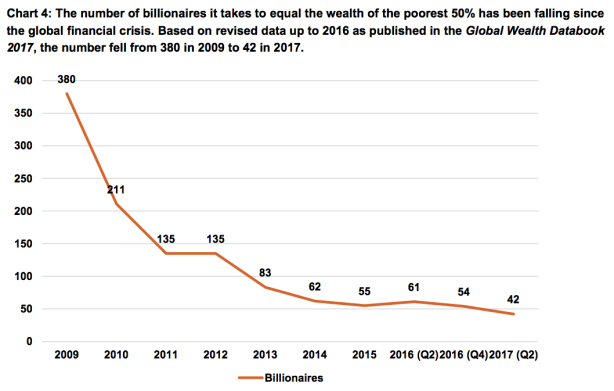From David Ruccio According to Oxfam’s analysis of data produced by Credit Suisse (which I analyzed in a different manner late last year), 42 billionaires now own the same wealth as the bottom half—3.7 billion people—of the world’s population. Together, those 3.7 billion people own only one half of one percent (0.53 percent) of the world’s wealth, a figure that rises to just about one percent (0.96 percent) when net debt is excluded. In 2017, 42 billionaires on the Forbes billionaires list had a cumulative net worth of ,498 billion—more than the wealth of the bottom 50 percent. When debt is excluded, that figure rises to 128 billionaires, who had a net worth of ,694 billion. Over the last decade, ordinary workers have seen their incomes rise by an average of just 2 percent a
Topics:
David F. Ruccio considers the following as important: Uncategorized
This could be interesting, too:
tom writes The Ukraine war and Europe’s deepening march of folly
Stavros Mavroudeas writes CfP of Marxist Macroeconomic Modelling workgroup – 18th WAPE Forum, Istanbul August 6-8, 2025
Lars Pålsson Syll writes The pretence-of-knowledge syndrome
Dean Baker writes Crypto and Donald Trump’s strategic baseball card reserve
from David Ruccio
According to Oxfam’s analysis of data produced by Credit Suisse (which I analyzed in a different manner late last year), 42 billionaires now own the same wealth as the bottom half—3.7 billion people—of the world’s population.
Together, those 3.7 billion people own only one half of one percent (0.53 percent) of the world’s wealth, a figure that rises to just about one percent (0.96 percent) when net debt is excluded.
In 2017, 42 billionaires on the Forbes billionaires list had a cumulative net worth of $1,498 billion—more than the wealth of the bottom 50 percent. When debt is excluded, that figure rises to 128 billionaires, who had a net worth of $2,694 billion.
Over the last decade, ordinary workers have seen their incomes rise by an average of just 2 percent a year, while billionaire wealth has been rising by 13 percent a year—nearly six times faster.
Without a fundamental change in economic institutions, the arc of capitalist history will continue to bend toward greater inequality.

